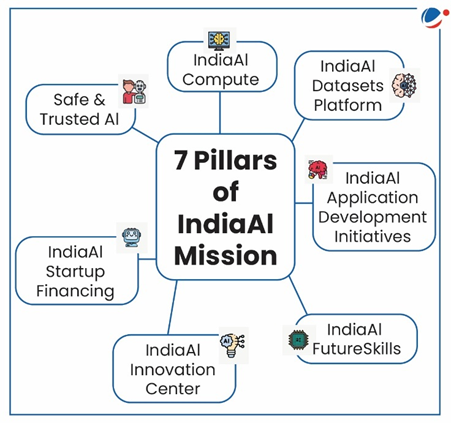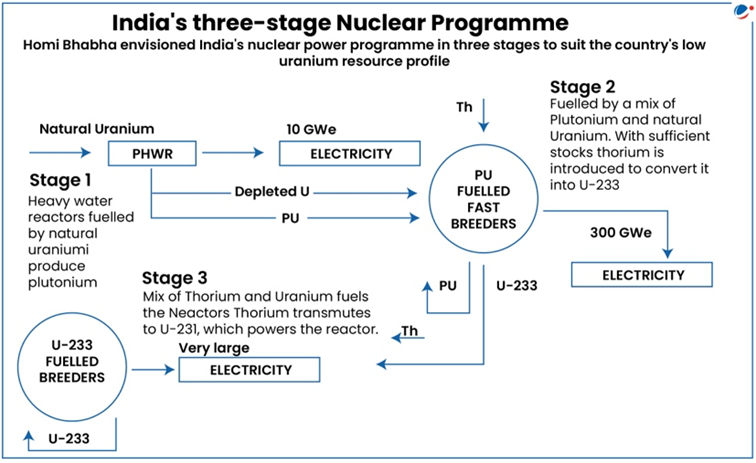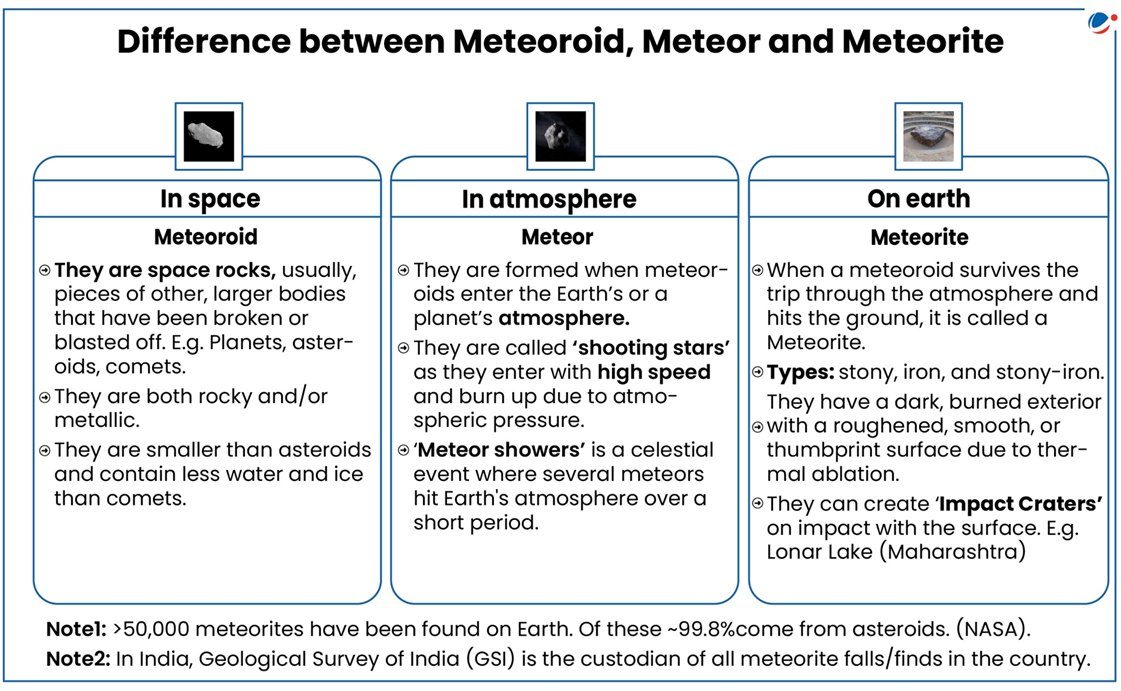Obesity
Recently Prime Minister stated that in 2022, one in eight people globally is living with obesity with cases among children and adolescents (5 to 19 years) has quadrupled.
- PM also called for 10% cut in edible oil consumption to fight obesity.
About Obesity
- Defined as an abnormal or excessive fat accumulation that presents a risk to health (World Health Organization).
- Body Mass Index (BMI) is used to classify obesity. It is calculated by dividing a person's weight in kilograms by their height in meters squared (kg/m²).
- BMI of 25 or above is considered overweight and 30 or above is classified as obese.
- Health Consequences: Rising cardiovascular diseases, diabetes, cancers, neurological disorders, chronic respiratory diseases, etc.
Status of obesity in India as per NFHS-5 (2019-2021)
- Overall, 24% of women and 23% of men are overweight or obese.
- At all India level, Child (under 5 years) overweight rates increased from 2.1% to 3.4% between 2015-16 and 2019-21.

Factors Driving obesity in India
- High-Calorie, Low-Nutrient Diets: Increased consumption of refined carbohydrates, saturated fats and easy access to processed foods.
- Sedentary Lifestyles: Long sitting hours, excessive screen time, minimal movement in daily routines etc.
- Use of Genetically modified crops: Altered food composition, impacting metabolism and weight gain.
- Tags :
- Obesity
- BMI
National Gene Bank
Union Government has announced the establishment of second National Gene Bank (NGB) to conserve 10 lakh crop germplasm, ensuring future food and nutritional security.
- The first NGB was established in 1996 at the ICAR-National Bureau of Plant Genetic Resources (NBPGR) in New Delhi.
About Gene Banks
- Gene banks are biorepositories that store genetic material of plants, animals, and microorganisms to preserve biodiversity and ensure long-term food security.
- Types of Gene Banks: Seed Banks (Svalbard Global Seed Vault, Norway), Field Gene Banks (live plants conserved in natural conditions), Cryo-preservation Banks (preserve tissues, embryos, and cells), Pollen and DNA Banks, etc.
- Other Gene Banks in India
- Animal Gene Bank: ICAR-National Bureau of Animal Genetic Resources (NBAGR), Haryana.
- Microbial Gene Bank: ICAR-National Bureau of Agriculturally Important Microorganisms (NBAIM), Uttar Pradesh.
- Tags :
- National Gene Bank
- Microbial Gene Bank
- Animal Gene Bank
Articles Sources
Transgenic Organism
Transgenic mice is in spotlight following the US President misstatement on ‘transgender mice’ funding.
- Transgenic refers to an organism or cell whose genome (entire set of DNA instructions found in a cell) has been altered by the introduction of one or more foreign DNA sequences from another species.
About Transgenic Organisms

- Concept: Transgenic organisms express new traits or proteins not native to their species, with 'trans' meaning from 'one to another' and 'genetic' referring to genes.
- Transgenic Mouse: key model for studying biological processes due to its physiological, anatomical, and genomic similarities with humans.
- Purpose & Applications
- Understanding Normal Physiological Processes: E.g., Transgenic mice created to study metabolism & blood cell production.
- Modeling Human Diseases: E.g., Transgenic pigs, used to model human diseases like Alzheimer's.
- Developing New Treatments: E.g., Transgenic zebrafish, accelerate drug testing & therapy development.
- Production of Therapeutic Proteins: E.g., Transgenic goats developed to produce human antithrombin (a blood-clotting protein).
- Disease Resistance Crops: E.g., Bt Cotton is genetically modified to be resistant to bollworms.
- Challenges
- Ethical Concerns: Related to animal welfare, and unintended consequences due to genetic modification.
- Environmental Risks: Potential for Transgenic organisms to disrupt ecosystems.
- Regulation in India: ‘Rules, 1989’ under the Environment (Protection) Act, 1986, Genetic Engineering Appraisal Committee (GEAC), etc.
- Tags :
- Transgenic
- Transgenic mice
Meity Launched Multiple Initiatives To Boost The AI Ecosystem
The initiatives have been launched under the IndiaAI Mission during its anniversary celebration.
Key Initiatives Launched

- AIKosha: IndiaAI Datasets Platform: A secured repository of datasets, AI models, and use cases with AI sandbox capabilities.
- IndiaAI Compute Portal: Provides subsidized AI compute, storage, and network services with access to 10,000+ graphics processing units (GPUs).
- A GPU is a circuit that performs mathematical calculations to process graphics and videos.
- AI Competency Framework: Equips public sector officials with AI skills and competency mapping.
- iGOT-AI for Government Officials: AI-powered personalized learning on the iGOT Karmayogi platform.
- Other Initiatives: IndiaAI Startups Global Acceleration Program, IndiaAI Innovation Challenge, and IndiaAI FutureSkills Fellowship.
About IndiaAI Mission
- Launched: March 2024, with a budget of ₹10,371.92 crore.
- Aim: Foster AI innovation through public-private partnerships and advanced AI infrastructure.
- It will be achieved by democratizing computing access, providing startup risk capital, ensuring socially impactful AI projects, bolstering ethical AI, etc.
- Ministry: An umbrella programme by MeitY.
- Implementing agency: 'IndiaAI' Independent Business Division under Digital India Corporation.

- Tags :
- AI
- IndiaAI Mission
- AIKosha
- IndiaAI Compute Portal
- iGOT-AI
Articles Sources
AI Washing
Venture capitalists are concerned about AI washing used by startups to secure funding.
About AI Washing
- AI washing is the practice of overstating or misrepresenting the use of AI in products, services or business strategies.
- AI washing takes its name from greenwashing, which is when companies make false or misleading claims about positive impact they have on the environment.
- Examples of AI Washing: Mislabelling automation as AI, Superficial AI claims , Using buzzwords phrases like “AI-driven” etc.
- Tags :
- AI Washing
National Innovation Challenge For Drone Application And Research (NIDAR)
The Ministry of Electronics and Information Technology (MeitY), in collaboration with the Drone Federation India (DFI), launched the NIDAR under the SwaYaan initiative.
- NIDAR aims to inspire and engage India’s student and research communities to develop collaborative autonomous drones, addressing real-world challenges in the field of Disaster Management and Precision Agriculture.
About SwaYaan
- Approved by MeitY in 2022.
- Focuses on capacity building for human resource development in Unmanned Aircraft Systems (UAS), including drones and related technologies.
- Tags :
- Drones
- NIDAR
- SwaYaan
Articles Sources
North India’s First Nuclear Power Project
North India’s first nuclear power project will be established in Gorakhpur, Haryana.
- Gorakhpur project consists of two twin units, each with a Pressurized Heavy Water Reactor (PHWR), for a total capacity of 2800 MW
About PHWR

- A PHWR uses Heavy Water (D2O) as both coolant and moderator, with natural uranium as fuel.
- Heavy water is water that contains heavy hydrogen (also known as deuterium) in place of regular hydrogen.
- Heavy water is used because it slows down neutrons effectively and also has a low probability of absorption of neutrons.
- India’s PHWR Development
- Introduced through Indo-Canadian nuclear cooperation in the 1960s.
- First 220 MW reactor built at Rajasthan Atomic Power Station (RAPS-1).
- After Pokhran-1 (1974), Canada withdrew support, leading India to indigenously develop and standardize the 220 MW PHWR design.
Recent Developments in Nuclear Energy in India
- Nuclear Energy Mission envisages deployment of 100 GWe of nuclear energy by 2047.
- India currently has about 8.1 GW installed.
- New Uranium Deposit discovered in India's oldest Uranium Mine, the Jaduguda Mines in Jharkhand.
- First two units of the indigenous 700 MWe PHWR at Kakrapar, Gujarat (KAPS - 3 & 4) have started commercial operation in FY 2023-24.
- Country's first Prototype Fast Breeder Reactor (PFBR 500 Mwe) achieved key milestones in 2024.
- NPCIL and NTPC formed ASHVINI, a Joint Venture to build and operate nuclear plants including the upcoming 4x700 MWe PHWR Mahi-Banswara Rajasthan Atomic Power Project.
- Tags :
- Nuclear power
- PHWR
- ASHVINI
NASA’s Astronauts Return To Earth After Being Stuck In Space For 286 Days
NASA astronauts, Sunita Williams and Butch Wilmore, had travelled to the International Space Station (ISS) on board Boeing’s CST-100 Starliner.
- Starliner experienced helium leaks and a malfunctioning thruster, which helps steer and control reentry making it unsafe for astronauts.
- Soviet cosmonaut Valeri Polyakov holds the record for the longest single stay in space, spending 438 days aboard the Mir space station.
Opportunities from Extended Stay
- Medical Research: Offers a rare chance to study unplanned long-term space exposure and its effects on the human body.
- Technology Testing: Helps assess how life-support systems, spacecraft, and onboard equipment perform beyond their intended mission durations.
- Deep-Space Mission Preparation: Provides valuable data for planning future Mars and lunar missions, where astronauts will spend extended periods in space.
Health Challenges in Space:
- Space Radiation: Exposure to cosmic rays and solar radiation increases the risk of cancer and other radiation-induced illnesses.
- Gravity Fields: Microgravity leads to muscle atrophy and bone density loss, while re-exposure to Earth's gravity can affect balance and coordination.
- NASA observes weight-bearing bone loss of 1% to 1.5% per month in microgravity.
- Isolation and Confinement: The psychological effects of being in confined spaces away from Earth can impact mental well-being and team dynamics.

- Tags :
- Starliner
- Astronaut return
- Sunita Williams
Starlink Satellite Internet
Indian telecom companies Airtel and Reliance Jio ink pacts with Spacex to bring starlink’s satellite internet services to India.
- Starlink is the world’s first and largest satellite constellation that uses Low Earth Orbit (LEO) to provide high-speed, low-latency broadband internet.
Satellite Internet
- It is a wireless internet through communication satellites orbiting the Earth and is location independent, providing global coverage.
- Satellites communicate with each other using lasers, reducing dependence on ground stations.
Starlink Satellite Internet Service
- Presently, there are around 7,086 starlink satellites in orbit.
- Each starlink satellite:
- Contains 3 space lasers (Optical Intersatellite Links or ISLs) operating at up to 200 Gbps, which together across the constellation form a global internet mesh.
- Uses 5 advanced Ku-band phased array antennas and 3 dual-band (Ka-band and E-band) antennas to provide high-bandwidth connectivity.

Significance of Satellite Internet
- Improving access: Suited for unconnected areas or areas with unreliable connectivity.
- Connectivity during Disasters: Starlink provided connectivity to Tonga after a massive volcano eruption and tsunami.
- Military applications: Provides connectivity between military bases and military planes, ships, drones etc.
Concerns
- Astronomical Interference: Bright light emitted by satellites in the night sky could interfere with astronomical observations.
- Atmospheric changes: Plan to steering out of service starlink satellites into Earth’s atmosphere risks altering the atmospheric chemistry.
- Technical limitations: Disruptions by extreme weather conditions and geomagnetic storms.
- Tags :
- Starlink
- Satellite Internet
Meteorite
Scientists confirm meteorite fall in a village in Beed (Maharashtra).
- Meteorites are when a meteoroid survives its trip through the atmosphere and hits the ground.

Significance of studying Meteorites
- Understanding Solar Systems: They contain in themselves past records of our solar system's history.
- Geological composition: They provide insights into geochemistry and mineral composition of the planets and solar system.
- Helps in understanding evolution of terrestrial planets including Earth and probe origin and evolution of life.
Exploration Initiatives
- NASA All Sky Fireball Network: It is a network of cameras to observe meteors in the sky brighter than Venus, which are called fireballs.
- Canada’s CMOR (Canadian Meteor Orbit Radar): It aims to detect the speed, direction, and location of meteoroids.
- Tags :
- Meteorite
- All Sky Fireball Network
Global Astrometric Interferometer For Astrophysics (GAIA)
European Space Agency (ESA) shut down its space observatory mission, GAIA.
About Global Astrometric Interferometer for Astrophysics (GAIA)
- It is a mission to chart a three-dimensional map of our Galaxy, the Milky Way.
- Gaia was positioned in Lagrange point 2 (L2), around 1.5 million kilometres ‘behind’ the Earth, when viewed from the Sun.
- Lagrangian Points are locations in space where gravitational forces and the orbital motion of a body balance each other.
- Objective: Designed for astrometry (the science of mapping the cosmos) through precise measurement of the location and movement of stars and other celestial bodies.
- Tags :
- GAIA
- Lagrangian Points
Abel Prize
Japanese mathematician Masaki Kashiwara (78) won the Abel Prize, often called the "Nobel of Mathematics."
- He was honored for his work in algebraic analysis, representation theory, D-modules, and crystal bases.
About the Abel Prize
- Annual award for outstanding mathematicians.
- Named after mathematicians Niels Henrik Abel (1802–29).
- Abel demonstrated the impossibility of solving the general quintic equation in radicals.
- He was also an innovator in the field of elliptic functions (Abelian functions).
- Established in 2002 by the Norwegian Government.
- Managed by the Norwegian Academy of Science and Letters.
- First winner: Jean-Pierre Serre (2003).
- Prize: 7.5 million kroner (~$720,000) and a glass plaque.
NOTE: International Mathematical Union, with UNESCO's support, declared 2000 as World Mathematical Year.
- Tags :
- Abel Prize
- Masaki Kashiwara



